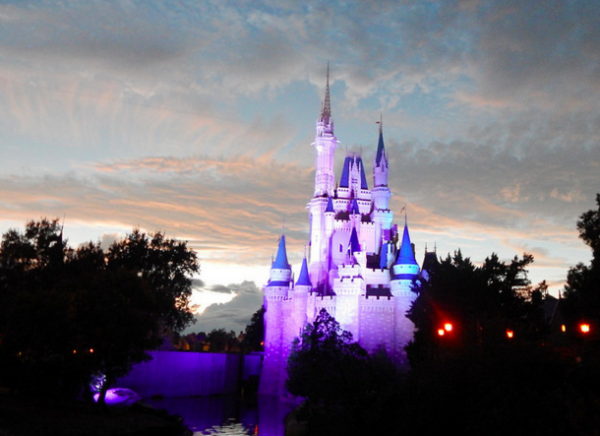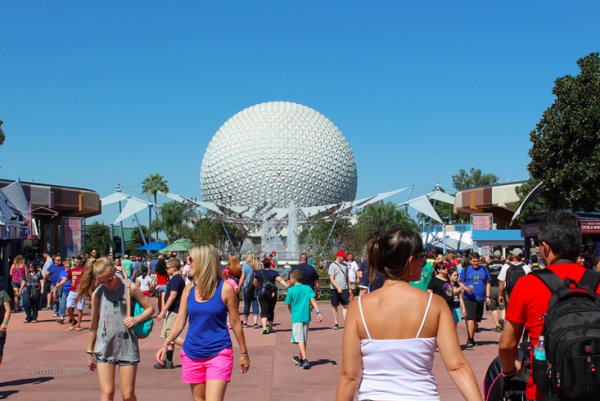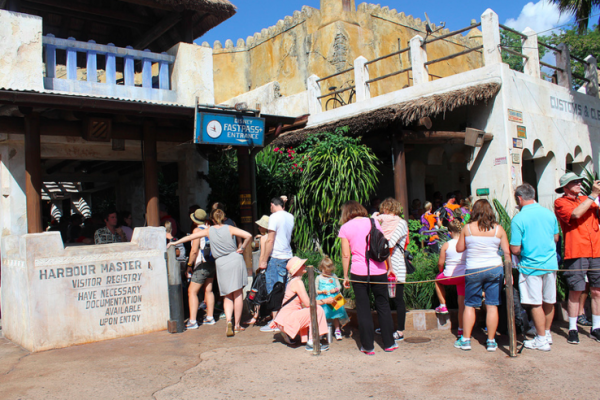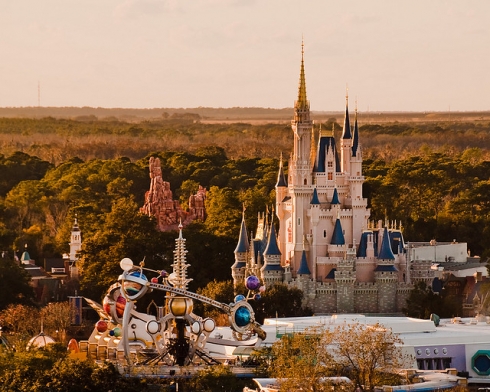Length of stay passes
Image: Disney
While Disney resort guests had long enjoyed small discounts on multi-day tickets, many found length of stay passes to be a real game changer. Although they debuted in 1993 as Be Our Guest Passports, there was no cost savings at that time. A five day Be Our Guest Passport cost exactly the same as a five day Super Duper Pass, and provided the same admission privileges. What was nice, however, was that Be Our Guest Passports were available for any number of days from two to six, depending on the number of hotel nights. Day guest multi-day tickets were available only in four or five day lengths.
In 1995, Be Our Guest Passports became Length of Stay Passes, which did offer a small cost savings over regular multi-day tickets. The lower price point coupled with the ability to customize the number of days helped Disney fill the resort rooms that they were furiously building during the Disney Decade. Beginning in 1997, E-Ticket Express (later named E Ride Nights) was a hugely popular add-on available only to resort guests. For $10 ($14.87 in today’s dollars), resort guests could enjoy the Magic Kingdom for three hours after regular park closing.
By the end of the decade, however, the Length of Stay Pass was gone. It was replaced by the Unlimited Magic Pass, which removed most of the perks and cost savings of the Length of Stay Pass.
Magic Your Way

Through the turn of the millennium, Disney admission prices continued to rise at a rate greater than inflation. In 2000, a one day ticket cost $46, or $63.75 in today’s dollars. By 2004, that same ticket cost $54.75, or $69.17 in 2015 dollars. Likewise, a seven day Park Hopper Plus cost $296 in 2000, or $410 in today’s dollars. It cost $342 in 2004, or $432.05 in 2015 dollars.
But the biggest game changer since all-inclusive admission was on the horizon. In 2005, Magic Your Way fundamentally altered everything we knew about Walt Disney World tickets. Like the airlines, Disney decided to “unbundle” tickets, letting guests pay only for what they wanted. And like the airlines, this led to some unexpected and fairly shocking results.
One of Disney’s most basic premises had always been that park tickets never expire. Guests were encouraged to plan ahead, buying more or longer tickets to lock in that day’s prices. But suddenly, all tickets would now expire within 14 days of first use - unless the guest paid extra to make them non-expiring. Park hopping and “Water Park Fun and More” (admission to the water parks and other minor attractions) became available as flat-fee add-ons.
So is Magic Your Way really a customizable ticket system that benefits the guest? Or is it a way to bury price increases under a confusing menu of choices? How have Magic Your Way ticket prices risen over the years, and how do those increases compare with the inflation rate?
We already know that in 2004, a one day adult ticket cost $46, or $63.75 in today’s money. In 2005, a one day Magic Your Way adult base ticket cost $59.75, or $73.01 in 2015 dollars - a pretty sizeable increase on par with the one in 1985. For multi-day tickets with all the trimmings, however, the story is quite different. In 2004, a seven day Park Hopper Plus cost $342, or $432.05 in today’s dollars. In 2005, a seven day Magic Your Way with No Expiration, Park Hopping, and Water Park Fun and More cost $334, or $408.12 in today’s dollars—an effective decrease of $15 after inflation.

Clearly, Magic Your Way was designed to keep guests on property spending money, as you might have already guessed. It was beneficial to those who wanted all the extra options, but not so good for those who just wanted to see the parks for a day or two. Let’s unbundle Magic Your Way, if you’ll pardon the pun, to see what is really going on.
The breakdown goes like this: Base tickets provide admission to one theme park per day for the number of days indicated on the ticket, up to a maximum of 10. Park Hopping, Water Park Fun and More, and No Expiration each require an extra fee. Yet the per-day cost of the ticket goes down as you add more days, as does the amortized cost of each add-on.
So guests began pulling out their calculators to figure out what the best combination of options was for each particular trip, and whether it was worthwhile to purchase extra days of admission plus the No Expiration option, to save for future visits. Rather than simply walking up to a ticket booth and buying an admission ticket, Magic Your Way became an exercise in frustration and confusion. At least Disney ended a bit of the confusion in 2013, when it discontinued the No Expiration option. Today, ALL Magic Your Way tickets expire 14 days after first use.
Incidentally, another side effect of Magic Your Way was the implementation of “like kind” rules involving ticket upgrades. Disney guests have always been welcome to upgrade their existing admission ticket to a pricier option and receive credit for the ticket already purchased. However, guests who purchase Magic Your Way tickets need to be careful when considering the Water Park Fun and More option. If you choose that option and then decide to upgrade your ticket to an annual pass, you will only be permitted to upgrade to a premium annual pass! Regular annual passes, which don’t include the water parks, are not an eligible upgrade from a Magic Your Way ticket that does include them.
So that’s the story behind Magic Your Way. But how have those ticket prices compared to inflation over their 10 years of existence?
In 2005, one day base tickets cost $59.75, or $73.01 in 2015 dollars. Today, a one day base ticket to the Magic Kingdom costs $111.83 - an increase of 1.5 times the inflation rate. And remember, a one day ticket back in 1981 cost only $31.50 in today’s dollars. So the effective price of spending a day at the Magic Kingdom has risen by 3.5 times the inflation rate since all-inclusive pricing was introduced, not including the increases in parking and food costs.
Pricing on longer tickets with more options has also risen faster than inflation. The seven day No Expiration Park Hopper with Water Park Fun and More cost $334 in 2005, which translates to $408.12 in today's dollars. But in 2015, the same ticket, without the discontinued No Expiration option, costs $452.63. In 1982, a six day World Passport with effectively the same perks was just $60, or $148.38 in today’s dollars. As Disney fans have long suspected, prices continue to rise at an astronomical rate while value continues to plummet.
Future considerations

It seems certain that Disney ticket prices will continue to rise, though the current inflation rate on tickets may well become unsustainable. But Disney seems to have yet another trick up its sleeve. Surveys went out earlier this year that suggest that the company will move to tiered pricing based on projected crowd levels. "Gold" days, such as major holidays, will cost more than "silver" days, which cost more than the traditionally slow "bronze" days. This a step further than Disneyland Paris' seasonal pricing model.
What if your trip spans a week consisting of days in all three categories? Some people postulate that you will have to pay a surcharge for each higher-tier day, while others speculate that the entire ticket will be priced at the per-day cost of the most expensive days. Seasonal passes, which would span at least bronze and silver days, not to mention annual passes that are valid on every day of the year, would almost certainly see a massive price hike.
Only time will tell whether this idea becomes a reality, and how it will affect ticket pricing as we understand it today. But if it takes effect, it is likely to cause a major ripple effect in how Disney fans plan their vacations.
Disney is a corporation that will charge what the market will bear. At this time, it seems clear that the market, or at least a significant portion of it, will pay the prices that Disney is charging. Is it worth it? Only you can answer that question for yourself. I invite you to share your thoughts in the comments!

Add new comment